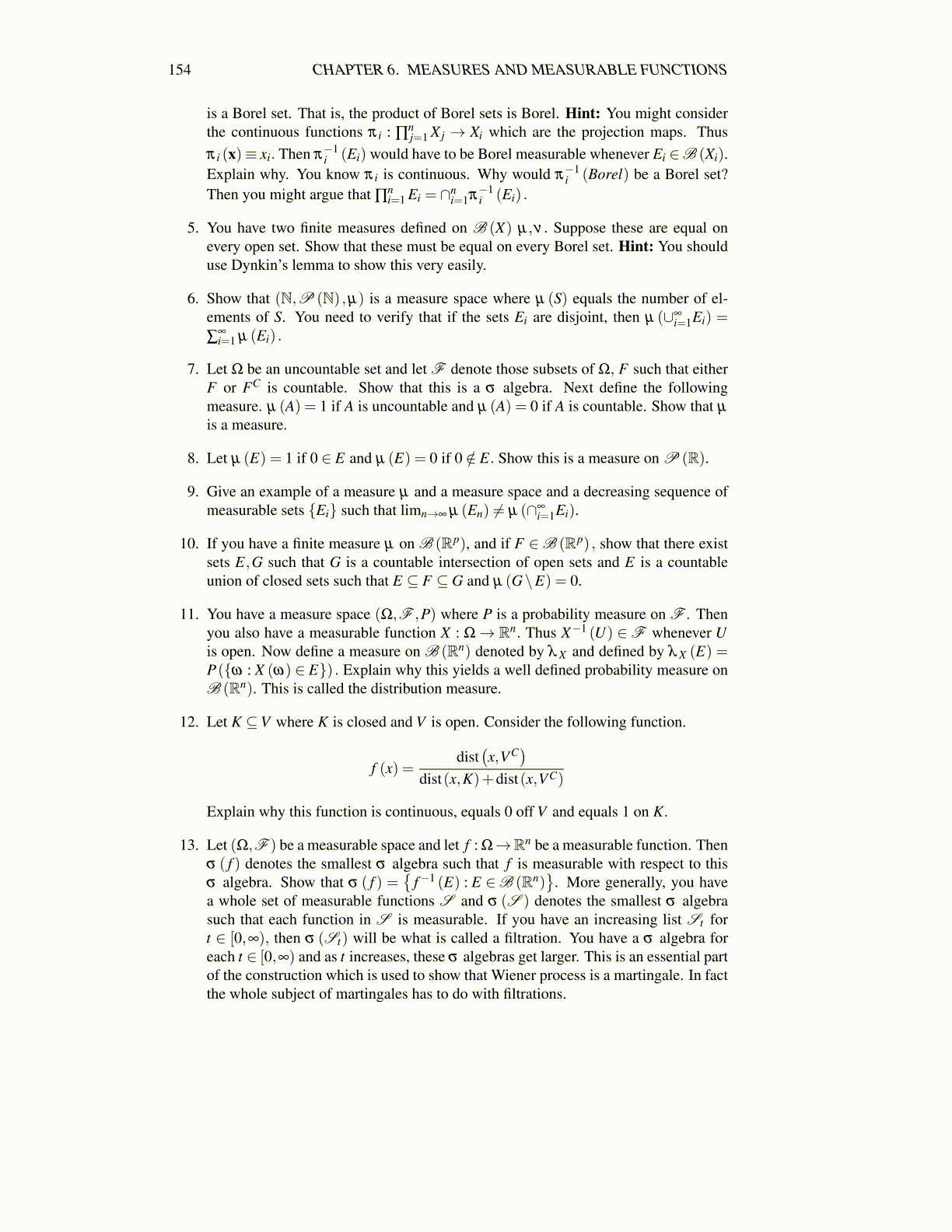
154 CHAPTER 6. MEASURES AND MEASURABLE FUNCTIONS
is a Borel set. That is, the product of Borel sets is Borel. Hint: You might considerthe continuous functions π i : ∏
nj=1 X j → Xi which are the projection maps. Thus
π i (x)≡ xi. Then π−1i (Ei) would have to be Borel measurable whenever Ei ∈B (Xi).
Explain why. You know π i is continuous. Why would π−1i (Borel) be a Borel set?
Then you might argue that ∏ni=1 Ei = ∩n
i=1π−1i (Ei) .
5. You have two finite measures defined on B (X) µ,ν . Suppose these are equal onevery open set. Show that these must be equal on every Borel set. Hint: You shoulduse Dynkin’s lemma to show this very easily.
6. Show that (N,P (N) ,µ) is a measure space where µ (S) equals the number of el-ements of S. You need to verify that if the sets Ei are disjoint, then µ (∪∞
i=1Ei) =
∑∞i=1 µ (Ei) .
7. Let Ω be an uncountable set and let F denote those subsets of Ω, F such that eitherF or FC is countable. Show that this is a σ algebra. Next define the followingmeasure. µ (A) = 1 if A is uncountable and µ (A) = 0 if A is countable. Show that µ
is a measure.
8. Let µ (E) = 1 if 0 ∈ E and µ (E) = 0 if 0 /∈ E. Show this is a measure on P (R).
9. Give an example of a measure µ and a measure space and a decreasing sequence ofmeasurable sets {Ei} such that limn→∞ µ (En) ̸= µ (∩∞
i=1Ei).
10. If you have a finite measure µ on B (Rp), and if F ∈B (Rp) , show that there existsets E,G such that G is a countable intersection of open sets and E is a countableunion of closed sets such that E ⊆ F ⊆ G and µ (G\E) = 0.
11. You have a measure space (Ω,F ,P) where P is a probability measure on F . Thenyou also have a measurable function X : Ω→ Rn. Thus X−1 (U) ∈F whenever Uis open. Now define a measure on B (Rn) denoted by λ X and defined by λ X (E) =P({ω : X (ω) ∈ E}) . Explain why this yields a well defined probability measure onB (Rn). This is called the distribution measure.
12. Let K ⊆V where K is closed and V is open. Consider the following function.
f (x) =dist(x,VC
)dist(x,K)+dist(x,VC)
Explain why this function is continuous, equals 0 off V and equals 1 on K.
13. Let (Ω,F ) be a measurable space and let f : Ω→Rn be a measurable function. Thenσ ( f ) denotes the smallest σ algebra such that f is measurable with respect to thisσ algebra. Show that σ ( f ) =
{f−1 (E) : E ∈B (Rn)
}. More generally, you have
a whole set of measurable functions S and σ (S ) denotes the smallest σ algebrasuch that each function in S is measurable. If you have an increasing list St fort ∈ [0,∞), then σ (St) will be what is called a filtration. You have a σ algebra foreach t ∈ [0,∞) and as t increases, these σ algebras get larger. This is an essential partof the construction which is used to show that Wiener process is a martingale. In factthe whole subject of martingales has to do with filtrations.